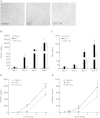Intracrine Androgens Enhance Decidualization and Modulate Expression of Human Endometrial Receptivity Genes
- PMID: 26817618
- PMCID: PMC4730211
- DOI: 10.1038/srep19970
Intracrine Androgens Enhance Decidualization and Modulate Expression of Human Endometrial Receptivity Genes
Abstract
The endometrium is a complex, steroid-dependent tissue that undergoes dynamic cyclical remodelling. Transformation of stromal fibroblasts (ESC) into specialised secretory cells (decidualization) is fundamental to the establishment of a receptive endometrial microenvironment which can support and maintain pregnancy. Androgen receptors (AR) are present in ESC; in other tissues local metabolism of ovarian and adrenal-derived androgens regulate AR-dependent gene expression. We hypothesised that altered expression/activity of androgen biosynthetic enzymes would regulate tissue availability of bioactive androgens and the process of decidualization. Primary human ESC were treated in vitro for 1-8 days with progesterone and cAMP (decidualized) in the presence or absence of the AR antagonist flutamide. Time and treatment-dependent changes in genes essential for a) intra-tissue biosynthesis of androgens (5α-reductase/SRD5A1, aldo-keto reductase family 1 member C3/AKR1C3), b) establishment of endometrial decidualization (IGFBP1, prolactin) and c) endometrial receptivity (SPP1, MAOA, EDNRB) were measured. Decidualization of ESC resulted in significant time-dependent changes in expression of AKR1C3 and SRD5A1 and secretion of T/DHT. Addition of flutamide significantly reduced secretion of IGFBP1 and prolactin and altered the expression of endometrial receptivity markers. Intracrine biosynthesis of endometrial androgens during decidualization may play a key role in endometrial receptivity and offer a novel target for fertility treatment.
Figures





Similar articles
-
Increased uterine androgen receptor protein abundance results in implantation and mitochondrial defects in pregnant rats with hyperandrogenism and insulin resistance.J Mol Med (Berl). 2021 Oct;99(10):1427-1446. doi: 10.1007/s00109-021-02104-z. Epub 2021 Jun 28. J Mol Med (Berl). 2021. PMID: 34180022 Free PMC article.
-
A role for steroid 5 alpha-reductase 1 in vascular remodeling during endometrial decidualization.Front Endocrinol (Lausanne). 2022 Nov 16;13:1027164. doi: 10.3389/fendo.2022.1027164. eCollection 2022. Front Endocrinol (Lausanne). 2022. PMID: 36465608 Free PMC article.
-
Decreased AMPK/SIRT1/PDK4 induced by androgen excess inhibits human endometrial stromal cell decidualization in PCOS.Cell Mol Life Sci. 2024 Jul 30;81(1):324. doi: 10.1007/s00018-024-05362-5. Cell Mol Life Sci. 2024. PMID: 39080028 Free PMC article.
-
Regulation of androgen action during establishment of pregnancy.J Mol Endocrinol. 2016 Jul;57(1):R35-47. doi: 10.1530/JME-16-0027. Epub 2016 Apr 11. J Mol Endocrinol. 2016. PMID: 27067639 Review.
-
Androgens and endometrium: New insights and new targets.Mol Cell Endocrinol. 2018 Apr 15;465:48-60. doi: 10.1016/j.mce.2017.09.022. Epub 2017 Sep 15. Mol Cell Endocrinol. 2018. PMID: 28919297 Review.
Cited by
-
Effects of Testosterone on the Expression of Connexin 26 and Connexin 43 in the Uterus of Rats During Early Pregnancy.In Vivo. 2020 Jul-Aug;34(4):1863-1870. doi: 10.21873/invivo.11981. In Vivo. 2020. PMID: 32606156 Free PMC article.
-
Chlamydia inhibits progesterone receptor mRNA expression in SHT-290 cells.Reprod Fertil. 2021 Mar 9;2(1):L9-L11. doi: 10.1530/RAF-20-0069. eCollection 2021 Jan. Reprod Fertil. 2021. PMID: 35128439 Free PMC article.
-
Insight on Polyunsaturated Fatty Acids in Endometrial Receptivity.Biomolecules. 2021 Dec 27;12(1):36. doi: 10.3390/biom12010036. Biomolecules. 2021. PMID: 35053184 Free PMC article. Review.
-
Metformin Ameliorates Uterine Defects in a Rat Model of Polycystic Ovary Syndrome.EBioMedicine. 2017 Apr;18:157-170. doi: 10.1016/j.ebiom.2017.03.023. Epub 2017 Mar 18. EBioMedicine. 2017. PMID: 28336389 Free PMC article.
-
miR-182 aids in receptive endometrium development in dairy goats by down-regulating PTN expression.PLoS One. 2017 Jul 5;12(7):e0179783. doi: 10.1371/journal.pone.0179783. eCollection 2017. PLoS One. 2017. PMID: 28678802 Free PMC article.
References
-
- Abraham G. E. Ovarian and adrenal contribution to peripheral androgens during the menstrual cycle. J Clin Endocrinol Metab 39, 340–346 (1974). - PubMed
Publication types
MeSH terms
Substances
Grants and funding
LinkOut - more resources
Full Text Sources
Other Literature Sources
Research Materials
Miscellaneous

